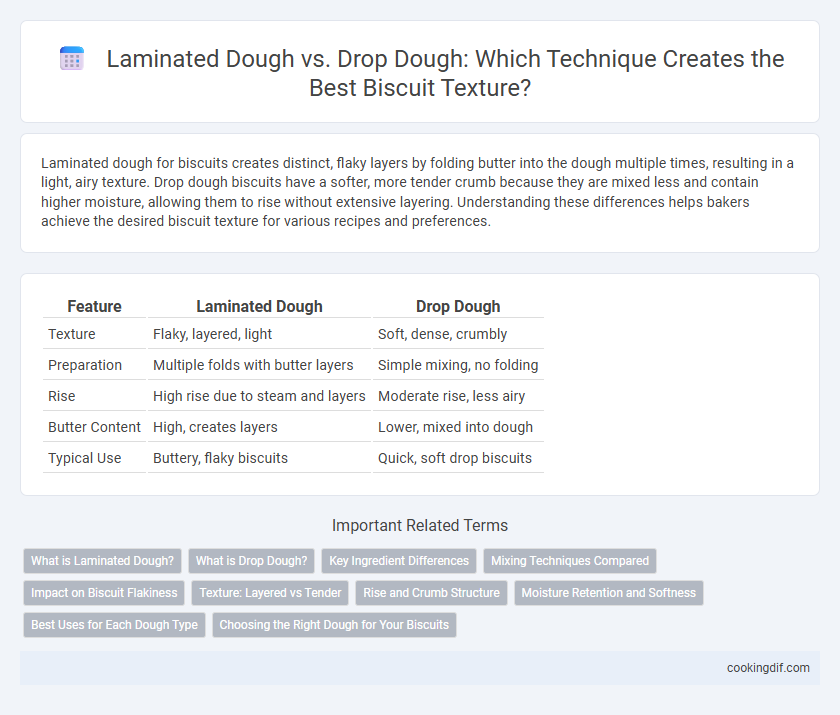Laminated dough for biscuits creates distinct, flaky layers by folding butter into the dough multiple times, resulting in a light, airy texture. Drop dough biscuits have a softer, more tender crumb because they are mixed less and contain higher moisture, allowing them to rise without extensive layering. Understanding these differences helps bakers achieve the desired biscuit texture for various recipes and preferences.
Table of Comparison
| Feature | Laminated Dough | Drop Dough |
|---|---|---|
| Texture | Flaky, layered, light | Soft, dense, crumbly |
| Preparation | Multiple folds with butter layers | Simple mixing, no folding |
| Rise | High rise due to steam and layers | Moderate rise, less airy |
| Butter Content | High, creates layers | Lower, mixed into dough |
| Typical Use | Buttery, flaky biscuits | Quick, soft drop biscuits |
What is Laminated Dough?
Laminated dough is a pastry dough technique involving multiple layers of butter and dough folded together to create distinct, flaky layers that produce a light and crisp biscuit texture. This dough contrasts sharply with drop dough, which is a softer, more homogenous mixture that results in denser, crumbly biscuits. The lamination process enhances tenderness and flakiness, making laminated dough ideal for biscuits with a delicate, airy bite.
What is Drop Dough?
Drop dough is a high-moisture biscuit dough that is soft enough to be scooped or "dropped" onto baking sheets rather than rolled and cut, resulting in a tender and loose crumb texture. Unlike laminated dough, which involves layering butter to create flaky, layered biscuits, drop dough relies on chemical leavening agents like baking powder for lift and produces a more cake-like, moist interior. Drop dough biscuits typically have a rougher, rustic appearance and a softer bite due to their higher hydration and minimal handling.
Key Ingredient Differences
Laminated dough biscuits incorporate layers of butter folded into the dough, creating a flaky texture due to steam released during baking, with key ingredients including cold butter, flour, and leavening agents. Drop dough biscuits rely on a higher moisture content and more leavening agents, such as baking powder or baking soda, resulting in a softer, tender crumb with a crumbly texture. The major ingredient difference lies in the method of fat incorporation--solid layers in laminated dough versus mixed fat in drop dough--impacting the final biscuit's texture and flakiness.
Mixing Techniques Compared
Laminated dough for biscuits involves folding and layering butter within the dough, creating distinct flaky layers and a tender crumb through controlled mixing that minimizes gluten development. Drop dough requires a gentler mixing technique that combines ingredients just until moistened, producing a softer, denser texture with less rise due to higher moisture and less aeration. Precise mixing in laminated dough preserves butter layers for flakiness, while careful handling of drop dough ensures a cohesive, moist biscuit without overworking the gluten.
Impact on Biscuit Flakiness
Laminated dough creates distinct, thin layers by folding butter into the dough, significantly enhancing biscuit flakiness with a light, airy texture. Drop dough incorporates fat more uniformly without layering, resulting in a denser, softer biscuit with minimal flakiness. The lamination process directly influences the biscuit's texture by producing crisp, flaky layers, whereas drop dough yields a tender but less flaky crumb.
Texture: Layered vs Tender
Laminated dough produces biscuits with a distinct layered texture due to the multiple folds of butter and dough, creating flaky, crisp layers. Drop dough results in tender biscuits with a softer, more crumbly texture because the dough is mixed less and contains higher moisture. The choice between laminated and drop dough directly impacts whether the biscuit texture is flaky or soft and delicate.
Rise and Crumb Structure
Laminated dough produces biscuits with a flaky texture and layered crumb structure due to the folding process that traps steam, resulting in significant rise and light, airy layers. Drop dough yields a softer, more tender biscuit with a denser crumb and moderate rise because the batter is less manipulated, allowing fewer air pockets to form during baking. The choice between laminated and drop dough directly affects crumb aeration and biscuit height, critical factors for achieving either a flaky or tender biscuit texture.
Moisture Retention and Softness
Laminated dough biscuits exhibit superior moisture retention due to their multiple thin layers of dough and fat, which trap steam during baking and create a tender, flaky texture. Drop dough biscuits, made from a wetter batter, retain moisture within a denser crumb, resulting in a softer but less flaky biscuit. The laminated method enhances softness alongside flakiness by limiting moisture loss, whereas drop dough relies on hydration levels for softer texture but lacks the layered structure.
Best Uses for Each Dough Type
Laminated dough, characterized by its multiple layers of butter and dough, produces biscuits with a flaky, tender texture ideal for breakfast or savory varieties requiring a delicate crumb. Drop dough, being wetter and softer, yields biscuits that are moist and tender with a rustic appearance, making it perfect for casual meals, such as shortcakes or sausage biscuits. Selecting laminated dough suits recipes emphasizing flaky layers, while drop dough is best for quick, easy preparation and softer textures.
Choosing the Right Dough for Your Biscuits
Laminated dough creates biscuits with distinct flaky layers and a tender crumb by incorporating layers of fat through folding and rolling, ideal for achieving a delicate, buttery texture. Drop dough produces a softer, more cake-like biscuit with a moist interior and a less structured crumb, perfect for quick preparation and a tender bite. Selecting between laminated and drop dough depends on the desired texture, layering, and preparation time for your biscuit recipe.
Laminated dough vs drop dough for biscuit texture Infographic

 cookingdif.com
cookingdif.com